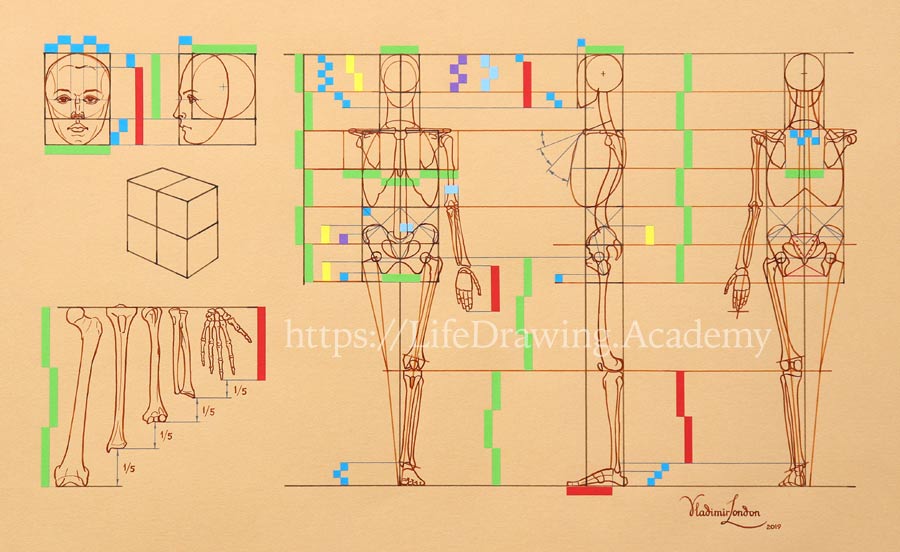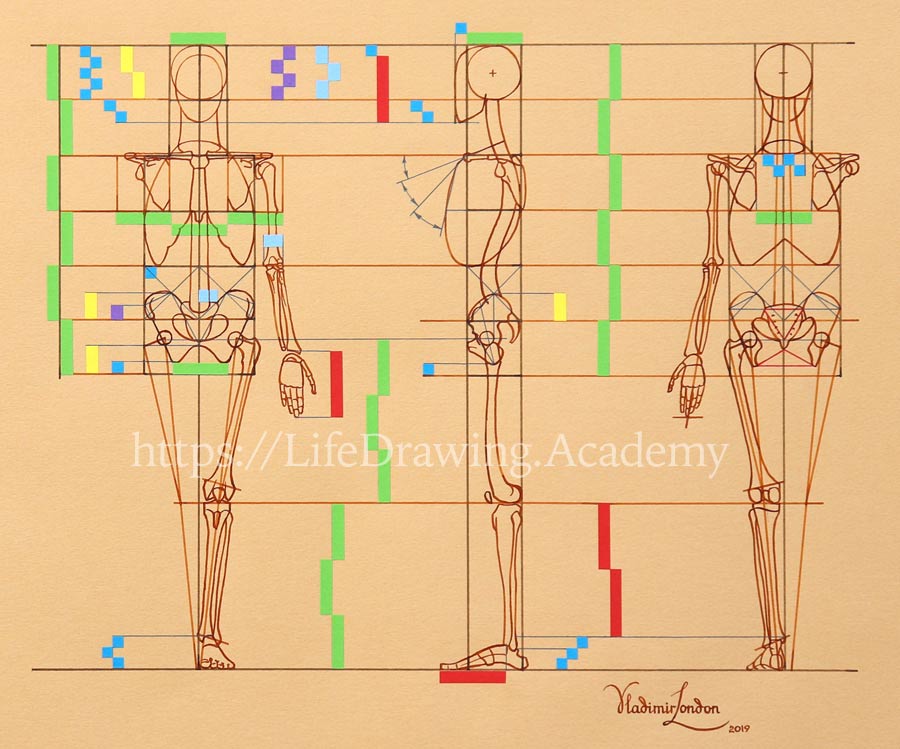Proportions of a Human Body
This is your unique chance to get a lifetime academy membership and a dedicated team of art teachers.
Such unlimited personal tutoring is not available anywhere else.
Enroll in the Life Drawing Academy now!
Human Body Proportions - Canon 2
By Vladimir London
In this video, we will continue discovering different canons of human body proportions. This particular canon is inspired by Robert Beverly Hale, an American artist and instructor of artistic anatomy.

I will use a ruling pen, a metal-nib pen, and sepia ink to make a drawing with precision on colored paper. This is more "engineering" than artistic drawing, so I will use a ruler here.
We start with a square. The width of the square is divided into five equal parts. I mark them in blue.
Each part represents the width of a human eye. I will actually draw eyes according to this measurement, using a lighter shade of sepia ink.
The distance between the eyes is equal to the width of one eye. So, the square's side is equal to five eyes. This will be our measuring unit.
A circle can be inscribed into that square. It spans from the top of the head to the base of the nose. Two more eyes are added at the bottom. This gives us a rectangle that is five eyes wide and seven eyes tall.
The height of the face takes six eyes. This dimension is marked in red here. The width of the head is color-coded in green. It is equal to five eyes or one measuring unit.
Here's another square that will be used for the head's side view.

We add one eye to its width and two eyes at the bottom. So, the rectangle of the head in the side view measures six by seven eyes.
To the circle of the cranium we add the facial part of the head, which resembles a big oval. So, the full volume of the head here consists of a circle and an oval.
Now, let's examine the proportions of the body. Two horizontal lines serve as the top and bottom borders of the figure. I will place the figure's vertical axis. The five-eye square is the main measuring unit in this canon.
We place two such squares here. The second square represents the distance from the base of the nose to the pit of the neck.
The five-eye square can be used to form a cube. Four such cubes form the volume of the ribcage. I will mark the main measuring unit in green here.
The width of the head fits four times from the top of the figure to the bottom of the ribcage. The circle of the cranium is five eyes in diameter. The distance from the base of the nose to the chin is equal to two eyes.
The height of the head takes seven eyes.
I will oversimplify the outlines of the body. A ribcage looks like an egg. Its widest part is just below the end of the breastbone.
At the bottom, the ribcage is two eyes narrower than its widest part.
Two shoulder blades can be inscribed into five eye squares. The distance between those squares is equal to five eyes.
The height of a shoulder blade is equal to five eyes, yet its width is slightly less because we see the shoulder blades as foreshortened in this point of view.
Four five-eye cubes are added below the ribcage.
The top two cubes are divided in half. This measurement is coded in yellow. This is where the top of the pelvis is. You can see that its top outlines go through the geometrical centers of the two top cubes.
One-fourth of the five-eye measuring unit helps us to locate the widest part of the pelvis. One-half of the five-eye measuring unit is the distance from the bottom edge of the square to the pubic bone.
The distance from that edge to the bottom of the pelvis is one eye. The width of the bottom part of the pelvis is five eyes. One-third of the five-eye measuring unit is the half-width of the sacrum.
The upper leg from the hip joint to the knee joint is equal to three measuring units. The same measurement applies to the lower leg from the knee joint to the ground.
The distance from the ground to the medial ankle is three eyes. The height of the face is six-sevenths of the head's height. It is marked in red. The height of the face is the same as the length of the hand. One-third of the measuring unit is the width of the elbow joint.
I will now draw the depth of the body to depict its side view. This depth is equal to the five-eye measuring unit. We add one eye to get the depth of the head in the side view. And also, we add two eyes to get the height of the head. Once again, the cranium is simplified as a circle. And the facial part of the head is an oval.
The five-eye measuring unit is used to define:
- the pit of the neck level
- the ribcage
- and the waist and pelvis region.
I will now draw stylized outlines of the ribcage and the spinal column...
[ The full lesson is avaibale to Life Drawing Academy members ]
This is your unique chance to get a lifetime academy membership and a dedicated team of art teachers.
Such unlimited personal tutoring is not available anywhere else.




